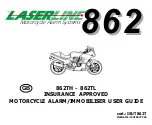
INST APD0191 C081230
LOCATION PREREQUISITES
This guideline contains general information on duct smoke detec-
tor installation, but does not preclude the NFPA and/or ICC docu-
ments listed. Air Products and Controls assumes no responsibility
for improperly installed duct detectors. To determine the correct
installation position for an SM-501 Series duct smoke detector, the
following factors must be considered.
1)
A uniform non-turbulent (laminar) airflow between
500 ft/min. to 4,000 ft/min. must be present in the HVAC
duct. To determine duct velocities, examine the engineering
specifications that define the expected velocities or use
an Alnor model 6000AP velocity meter (or equivalent).
2)
To minimize the impact of air turbulence and stratification
on performance, a duct smoke detector should be
located as far as possible downstream from any
obstruction (i.e. deflector plates, elbows, dampers, etc.).
In all situations, confirmation of velocity and pressure
differential within specifications is required.
The pressure differential between the input sampling (high
pressure) tube and exhaust (low pressure) tube for the
SM-501 Series smoke duct detector should be
greater than 0.01 inches of water and less than 1.2 inches
of water.
3)
Identify a code compliant location (supply or return side,
or both) for the installation of the duct unit that will permit
easy access for viewing and serviceability.
4)
When installing on the return side, install duct units prior
to the air being exhausted from the building or diluted with
outside “fresh” air.
5)
When installing duct smoke units downstream of filters,
fires occurring in the filters will be detected, but if the
filters become blocked, insufficient air flow through the
duct unit will prevent the correct operation of the duct
detector. Duct units installed in the supply air side may
monitor upstream equipment and/or filters.
6)
Where possible, install duct detectors upstream of air
humidifiers and downstream of dehumidifiers.
7)
To prevent false alarms, the duct detector should not be
mounted in areas of extreme high or low temperatures, in
areas where high humidity exists, or in areas where the
duct may contain gases or excessive dust.
SAMPLING TUBE ASSEMBLY
Sampling tubes are to be ordered separately in one of four stan-
dard lengths.
STS-1.0
For duct widths of 6” TO 1.0’
STS-2.5
For duct widths of 1.0’ TO 2.5’
STS-5.0
For duct widths of 2.5’ TO 5.0’
STS-10.0
For duct widths of 5.0’ TO 10.0’
Standard sampling tubes are steel tubes with air intake holes
drilled the entire length of the tube. These tubes must be cut to
length and should span the entire width of the duct. Sampling
tubes over 3.0’ must be supported on the opposite side of the duct.
MECHANICAL INSTALLATION
To ensure the correct operation of the sensing tube, the red end
cap (red stopper in installation kit) must be inserted in the end of the
air intake sampling tube. For custom duct widths, always use the
next longest standard size and cut down to the exact requirement.
Once the airflow direction has been determined, insert the inlet
and exhaust tubes into the sampling tube connectors fitted to the
back of the duct smoke detector which are equipped with set
screws. These connectors will allow the tubes to be correctly ori-
entated and secured by tightening the set screw. Ensure air
intake sampling tube is positioned so that the inlet holes are
directly facing the airflow.
DUCT PREPARATION
Remove mounting template from the installation kit. Remove
paper backing from the mounting template and affix it to the duct
at the desired location. Using the template as a guide, drill (4)
mounting holes (3/32” diam.) for the # 12 X 1/2” sheet metal
screws packaged in the installation kit. Drill or punch (2) 1 3/8”
holes for inlet sampling and exhaust tubes, using the template as
a guide. Clean all holes.
MOUNTING
After securing the sampling and exhaust tubes to the duct smoke
unit, (or initially placing the tubes through the 1 3/8” holes drilled
or punched in the HVAC duct to accept the inlet sampling and
exhaust tubes and then attaching them to the duct unit), hold the
duct unit assembly in position and use (4) # 12 X 1/2” sheet metal
screws (packaged in the installation kit) to secure the duct smoke
detector to the HVAC duct sheet metal.
AIR SAMPLING VERIFICATION
To ensure correct operation of the duct unit use a Magnehelic dif-
ferential pressure gauge, Dwyer 2000 or 4000 Series (or equiv-
alent) to determine the differential pressure between the inlet
(high side) and exhaust (low side) tubes. The differential pres-
sure between the two tubes should be greater than 0.01 inches
of water and less than 1.2 inches of water.
2
























